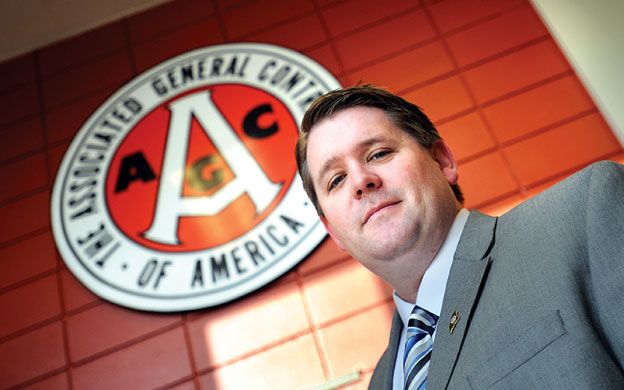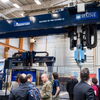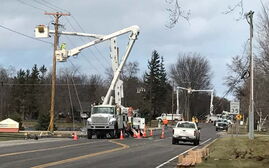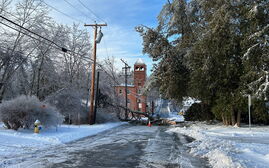New Associated General Contractors of Maine CEO lays out plan to revive the industry
 photo/amber waterman
Matt Marks, the new CEO of Associated General Contractors of Maine, says long-term plans for energy and infrastructure would improve the jobs picture for Maine's construction industry
photo/amber waterman
Matt Marks, the new CEO of Associated General Contractors of Maine, says long-term plans for energy and infrastructure would improve the jobs picture for Maine's construction industry
At its peak in 2006, Maine's construction industry had 32,000 jobs. Since the 2008 financial crash, the industry has lost 10,000 jobs, and has yet to show much sign of recovery. Matt Marks became CEO of Associated General Contractors of Maine, the local chapter of the national trade association for the construction industry, in August, after serving five years as COO. Mainebiz sat down with Marks at his office in Augusta to discuss why the slump has continued so long, and what AGC is doing to prepare for a rebound. An edited transcript follows.
Mainebiz: We're looking at the size of the industry in Maine, which had 32,000 jobs in 2006, and now has just 22,000 — a huge drop. What happened during those six years?
Marks: Well, a lot changed. When the financial crisis happened, banks certainly tightened up restrictions on lending — especially commercial lending. Large retail chains that are predominant here had met their capacity. And public infrastructure investment hasn't filled in the gap as it has in the past. Government looks to public infrastructure for help when times are tough, so flat funding certainly hasn't been beneficial.
So there really were no bright spots?
The [Central Maine Power Co.] reliability project and the transmission upgrade has been the sole bright spot. Energy, in general, has been bright over the past few years — the natural gas expansion and windpower.
Wind seemed to be taking off as Maine companies were developing expertise, not just for projects here, but elsewhere in New England. That's leveled off. What's holding back growth?
First and foremost is the federal wind production tax credit and whether it's going to be extended. Our hope is that happens before it expires Dec. 31 and there's a two-year extension. So from our perspective, two things have to happen: The wind tax credit has to have a length of term that will help investors feel a little more freedom to invest; and the country has to come up with a plan for wind energy, beyond the tax credit discussion.
Are there any factors within Maine that have held things back?
A couple of things. First of all, we certainly had some successes here. And you do have that sense that there are some folks who want to discuss viability, along with “not in my backyard” concerns. Over time, that generally happens with any type of industry, especially the energy sector. It's not unusual, but my hope is it doesn't stall investment in wind energy for Maine. It's certainly a bright future if we make that happen.
Are there any other indigenous sources? We do have an operating tidal power plant, though it's pretty small. Could solar eventually contribute?
They could. Tidal energy is certainly unique. We had a member company that built the components and did the installation. Any time we can look at energy made at home we're a lot better off. And particularly in Maine, where we rely heavily on heating oil. Being diverse is how we win with energy. We look at hydro, tidal and wind. I don't think Maine's in the best spot for solar, though when we start talking about small residential installation, some of that may work. But we really have to focus on the big picture, which is large commercial installation. If we think only small residential, it's going to be very tough to execute a return on investment.
Transportation has long been a concern here in the sense that we might not have a system good enough to compete. But there's also the idea of connecting to other parts of the country and the world that could prompt activity here. Do you see any signs we might be getting closer?
I think so. The shortfall for Maine infrastructure investment, according to the Department of Transportation, is $150 million a year. The AGC infrastructure report card that comes out every few years is due soon, and I'm anxious to see it. With our aging infrastructure, we've been fortunate not to have had any major mishaps. But it's not difficult to see the impacts. You look at the Maine-New Hampshire border, having a major bridge that needed to be reconstructed on an emergency basis. And then you look at the East-West corridor, that we can't cross our state efficiently. We're one of the few states in New England where we can't get east-west. The same is true for the southern part of the state. We have to be able to move people efficiently. Maine has a lot of roads with a lot of maintenance issues.
Will there be more resources? This is one sector that's uniquely dependent on public spending, and there hasn't been a lot of willingness to invest.
Gov. LePage certainly wants to see us invest more money in public infrastructure, but at the same time he has a pretty big burden on his shoulders, to reduce the debt we currently have. Over time, everything has to be balanced. My hope is that we continue to invest in infrastructure because that problem's not going away. It's going to get bigger. And today, the state is about 15% under budget on the projects they bid. Folks are hungry for work. So there's not a better time to invest in public resources.
In the commercial sector, clearly we had a lot of excess capacity. Will that change, or are we looking at a slow market for awhile?
Residential and commercial are tied together. We were at a conference recently, and an economist from the U.S. Chamber of Commerce said that until the housing market grows, you're not going to see the economy make that next jump. You've got folks living in homes they can't afford, and other folks who can't get into a home. They make good money, but the banks won't lend. That's really important for the entire economy. The investment in commercial and retail depends on the same factors. That isn't going to change overnight.
How about other sectors?
One that's important for us is school construction. We're seeing local municipalities taking large-scale projects. Scarborough's was about $28 million; and South Portland's in the $40 million to $45 million range. They're funded by local taxpayers. That's a big change.
There was a big flood of state money earlier, but not recently.
We knew that was going to happen, and the towns that didn't anticipate getting funds had to make a decision. We've had two big projects, and may see some others in the near future.
Are those good for the Maine construction industry? It's mostly local work?
Not only is it local work, but there's a lot of subcontractors. And that's a piece that's often forgotten — electricians, site-work contractors, plumbers — you pick.
So new construction is better for Maine firms than retrofits?
We've done a lot of retrofit work in the last year, and our forecast was that we'd see more. Especially with retail outfits coming and going, instead of building new, they just remodeled. But new construction is a big segment of our market. It encompasses everything.
We also talked about efficiency, and how that can help the industry, but it remains challenging because costs are rising for materials and labor even though budgets are not increasing.
You have to be more efficient today. We now have BIM — Building Information Modeling — and the ability to see the project before construction. It helps reduce costs, waste, spending and [coordinates] schedules. These technologies are making the industry more efficient. And look at some of the new technology, such as GPS. You see contractors today using GPS in all their equipment, even bulldozers. It's amazing to see what's changed in such a short amount of time.
On bigger projects, does the design-build concept hold opportunity? It's been used on bridges and the new hospital in Augusta. Is that a way to become more efficient?
We're looking at a bunch of different delivery methods, and I think those will be explored, but I don't think all the answers are there yet for design-build. It depends on the project.
There haven't been many large-scale redevelopment projects, though there is the old Brunswick Naval Air Station. They had an enormous surplus of space, but one assumes that as new uses get integrated, there may be more demand. Does it create opportunity?
We've had some members do work there, and the big need is to make sure it's accessible, so they can move traffic in and out. Then we can court developers who want to come in and take a stake there. Maine has done projects where they've encouraged developers with tax benefits, and Brunswick's certainly one of those.
How about the really tough projects downtown, old buildings that were difficult to do anything with for so long. With tax credits, with new building codes, some projects are now happening. Is that a new venue for firms you represent?
Absolutely. I toured the Saco Mill project. You look at those mills, and see just a ton of space that's been idle for years. There's a group in Lewiston working to save the Bates Mill. It would be a heck of a waste to get rid of those buildings if we can turn them into good retail/housing space. And, you know, this is a winning model. It's already out there, and I think that as more people realize these buildings are an important part not just of history, but of infrastructure development, you'll see more of those happening.
What would a healthy industry look like, in terms of jobs, and the kind of projects?
Maine and the country have to look at two important things — sectors that affect not just the construction market, but all of us. Maine needs a good energy plan, and so does the federal government. If we look forward not just one year, but five to 10 years, it'll lead us to the right path, which is jobs. We can't do that on a short-term basis. The same holds true for infrastructure. Maine, for a number of years, has neglected to repair its roads and bridges. We've done very little road construction. In the next budget they're talking about more construction, which is good. But promoting a long-term plan would be a key element of whether we're successful or not.
How about jobs?
Construction jobs are good jobs, and have a high average salary. A recent labor market study said these are going to be among the top jobs in the future. But the key is making sure we have the people here in Maine who can do it. While we have a glut now, as we start to grow again and the economy starts to recover, we need to make sure we have trained and qualified people who can return to work.
Training seems to be pretty important. Does it happen primarily in colleges and technical classes, or do companies invest in training as well?
All the trade associations have a training component. AGC does safety and OSHA training; we do management training. And a lot of companies do more on-the-job training. It's not just about safety, it's about the advancement of the industry. We're doing crane certifications, and this has been a big change. The requirement that by 2014, everybody has to have a certified crane license, is a big deal. At AGC, we've put a ton of people through to meet that demand. On the other side of the spectrum I wonder all the time why trades or crafts training in schools hasn't seen more investment. I understand the resource issues, but electricians, plumbers, carpenters — they're good jobs, and I'd hate to see them disappear.
Say you're a young person today, what would be the reasons you might go into construction?
I wouldn't recommend it to everyone, just as not everybody wants to be a fireman, or policeman, or teacher. But here you have some freedom. You have pride in the job. Whether you're a plumber or electrician, when that building's done, you played a part. It's a piece of the history of your community. The pay, on average, is better than most jobs. And you work with your hands. You're still going to use math and science, but not behind a desk. And that can be a plus. But we have a lot of people who do work behind their desks — designers, engineers. The construction industry is like a big family. And that's important, because you'll see a lot of people learn a trade who then open their own company down the road. So the opportunity can be pretty endless.
Douglas Rooks, a writer based in West Gardiner, can be reached at editorial@mainebiz.biz.














Comments